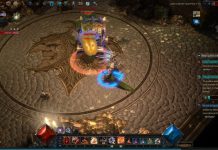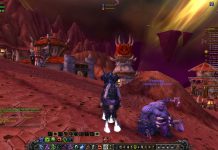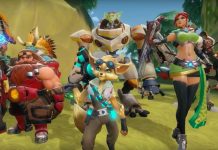It’s hard to describe Tyria—the land of Guild Wars 2—without actually experiencing it.
As a game, GW2 is a stunning development in the MMO scene that has pulled together a lot of great elements and is trying very hard to modify and innovate the way that people play MMO games. Far from becoming the massively single-player mechanism of Star Wars: The Old Republic, GW2 encourages groups and exploration from the get-go and it even includes a heroic single-player storyline for those who want that aspect of the game.
The game sports an aesthetic that makes it look like the scenes, UI, and effects appear to be oil-painted or water colored. It has excellent sound quality, full of voice acting that adds depth and dimension to the world—even the dynamic events have their own voicing. It’s easy to see how this game could run out of content really fast because there’s so much artwork and development that went into world building and it’s a subscription-less title.
So, without much further ado. GW2 is a fantasy-themed MMORPG developed by ArenaNet with a powerful PvE element and a huge PvP mechanism generated by World vs World. Almost everyone will find something to do in this game.
With a price tag of $59.99 GW2 is a buy-to-play game and it is not a free-to-play game although it falls into that spectrum where it does not have a subscription fee and it runs on a freemium mechanic.
Graphics and Sound: This is a AAA title to the core and holds nothing back when it comes to aesthetic
Breathtaking—much of Guild Wars 2 surrounds an art direction that generates sweeping vistas and huge maps, in a way that makes it seem like the zones are much larger than they are. In many ways, the maps are smaller than the ones that I’m used to in other MMO games, but they’re also filled with a lot more stuff. To this extent, the fact that the game does not have mounts is less of a problem.
No mounts? GW2 currently looks like it will not have mounts; if it does they will not be necessary for moving around the world swiftly. This feels a little bit odd at first, because I’m used to worlds having a sense of depth and distance given to me by how long it takes to get from place to place. However, GW2 does away with this by providing a teleportation system that allows people to jump between locations instantly (for free.)
Each zone has its own environment, aesthetic, and even ambient atmosphere—the sylvari zone is filled with green, splashes of color, flowers, and verdant verge; the charr zone is caked in red and orange, a blasted badlands filled with ghosts, and the echoes of strife; the human zone looks like mediaeval England with rolling green fields, orchards, centaurs, and giant spiders—looking over the asura zone is amusing because it includes metal and stone tilted cubes, mad science on display, and green jungles and forests.
Everywhere you go there’s something to see, something to enjoy; the buzzing of mosquitos, the crunch of snow beneath your feet, or the spang of metal on metal and the explosions of mortar bombardments in the distance.
Then there’s the music, it’s subtle enough that it doesn’t overwhelm the game—even when it ramps up into the full-throttle orchestral battle music when there’s an event on. Spells sizzling through the air, arrows singing in flight, and warriors blocking and swinging. All of this adds to the sounds that permeate the game and the music only completes that.
The best part of the sounds and images is that they go together very well. All you need to do is walk through a major city, such as the human major city and listen. Dogs bark, the burble of chatter follows you as crowds mingle, and the odd snatch of conversation bubbles up from a nearby group discussing the politics of the day.
Although there’s a lot of voicing, you do end up hearing the same thing said over and over. This is common to any MMO game. In a way, I think that GW2 could use to tone down how often voiced characters speak up or give them a lot more things to say. That’s really the only sound caveat that I have for the game in that vein; but for the most part they’ve done a great job with the sound.
Gameplay: Exploration, dynamic events…an innovation in almost every aspect of MMO gameplay
The initial launch of Guild Wars 2 was a little bit rocky. That is to say that people experienced lag left and right; there were service offline for much of the week (I’m looking at you Trading Post!) and the shards filled up toute suite leaving people on different servers than their friends.
However, ArenaNet does have a solution for this—but that doesn’t work very well either.
When a server has too many people on it, they get shuffled off onto something called the Overflow. This means that there’s no queues to wait to get into GW2. You can go straight in, you just end up in some odd world alongside other people form other servers who also got overflowed. ArenaNet is working on making sure that parties stay together even when moved into overflow but that’s a little bit broken.
Choosing a particular shard doesn’t separate you from your friends as a game such as World of Warcraft would; but instead it chooses what world you fight for in WvW. With the concept of the overflow server, this means that people in GW2 should be able to join their friends (if it starts working.)
Nuts and bolts time: there are five races: asura, charr, sylvari, human, and norn—each with their own starting area. There are eight professions: Mesmer, guardian, necromancer, ranger, elementalist, warrior. The races and professions (aka classes) cover the usual fantasy-MMORPG staple of roles; but in a big way many of these roles are mixed, all of them can heal to an extent, all can tank to an extent, and they’re all DPS range and close. Some are much better at particular roles than others; but it seems more like the game is all about letting people find a play style they like and then mold themselves into a role.
Now to the fun part.
In the game itself the world is a living place. Once a player launches into the game they’re immediately greeted with a tutorial that lets them try out their abilities and throws them into a giant boss fight (easy enough but it’s very enjoyable.) It also explains and opens up how the world functions.
GW2 does not have a standard quest system—instead quests or activities open up according to the area I wandered into. This means that there’s someone who needs a few tasks completed: feed the cows, kill the spiders, dig up termites, whatever-need-does-farm-here. And when those tasks got done I received a notice as to my progress. Whereupon completion I got some karma (a currency) and I could use that to purchase interesting things from the quest givers.
At no point did I have to hunt down an exclamation point or a turn it, I just did what came.
Then there’s dynamic events. In each area, random things happen, such as a bull escapes from the local pen, the undead rise from the ground and charge, a dragon lands and has to be tentspiked—whatever needs doing, I could get to it with a giant number of people. We’d all zerg onto the target and try to take them down. For the most part the dynamic events could be swarm-to-win, but I suspect that the mechanics might become more challenging the further into the game I go.
The two above parts really make this game more enjoyable; it also means that I found myself moving along and getting things done faster if I had a party—but I didn’t need one—because I could solo and just join in with other anonymous people in smacking down the hour’s big-bad-de-jeur.
Buy-to-Play: It’s $59.99 for the box with no subscription and a freemium model under the hood
From the outset, Guild Wars 2 has a pricetag and you’ll have to buy it to play. However, after that, there is no subscription so it falls down a freemium model similar to how Star Wars Online uses with a cash shop and the ability to trade the freemium currency (gems) for in game gold.
Looking at the cash shop, it contains the usual experience boosters, some aesthetic items, and a lot of service upgrades. Most notably there’s things such as extra character slots, the ability to buy the Digital Deluxe Edition upgrade (for about 2,000 gems or $25 USD.)
The ability to trade the freemium currency for in game gold is a brilliant move on the part of ArenaNet because it means that people with a lot of money and very little time to play can buy gems and trade them out for gold to progress in the game; this also means that people farming a lot or playing a lot can use their gold to buy gems and receive services, buffs, etc. from the cash shop easily.
In the end ArenaNet will make money off both transactions and it will support their business model of not having a subscription.
Conclusion: I love this game (although the pricetag is a bit high) and it’s an excellent showing
Playing Guild Wars 2 is a breath of fresh air in the MMO community. It’s a really good game with a little bit of a steep pricetag when it comes to the market of otherwise free-to-play games. Of course, it’s also obviously a triple-A title with a lot going for it and it’s building a culture extremely quickly.
Singing GW2’s praises, however, is dampened a little bit by their current rocky launch. The fact that I was stuck on a shard (where all my characters live) and it’s currently difficult to phase with my friends. It also means that there’s a lot of need for them to fix elements that permit better socialization.
Otherwise, this is not just a beautiful game, it’s a very active game.
It seems like it might run out of content quickly—as I mentioned above—but I am only critiquing the first 15 levels of 80 for all the races. I’ve been through the beginning zones for everyone and I’m looking forward to see the rest of the game. There is this itch to compare it to games such as World of Warcraft that have been with us for a decade; but that might be too cruel because WoW has had a chance to upgrade and repeatedly expand itself.
All that said, this is a very good MMORPG. If you can afford it, I’d say jump in and give it a spin—and a spin it is.

















Great write up Kit!
Epic review Kyt, I really like it, I hope I can join you one day 🙂
Great article, Kit:). I am enjoying Guild Wars 2 more every time I play it.
Really nice post. I like Guild Wars like a game but i cant afford it 🙁